Abstract
Australia has set up regulatory reforms aimed at improving and promoting its governance. Special attention has been directed towards such aspects as trade, market openness, competition and regulatory management. These reforms have enabled Australia to succeed in weathering the recent global financial crisis.
These reforms, together with the introduction of robust monetary and fiscal policies, have enhanced growth in the country. Effective trade policies such as dismantling of trade barriers and creation of Free Trade Agreements (FTAs) have enhanced greater and faster gains. Some of the major challenges that the country faces include, an increase in terms of trade and an ageing population.
In an effort to enhance its economic wellbeing, the government should set macroeconomic policies such as economic growth, inflation, unemployment and trade policies. In particular, the government should improve its infrastructural facilities and also promote force labor participation.
Introduction
It is apparent that the uncertainty that has gripped the world economy is slowly manifesting itself in Australia’s corporate sector, where chief executives are under pressure to put in place measures that will keep their companies afloat in the face of a receding global economy. As a result, every country should make progress towards restoring the macroeconomic stability. In order for macroeconomic stability to be achieved, all the stakeholders should be committed to policy implementation.
Australia has made considerable progress in enhancing its long-term economic stability. A vital question is to whether this economic growth can be sustained. This depends on the evolution of the fundamental determinants of economic growth, especially those that have contributed to the most growth improvements in recent years (United Nations, Economic and Social Council, United Nations, Office for ECOSOC Support and Coordination, 2004, 107).
The following research report focuses on the macroeconomic policy settings, currently being applied in Australia. The report examines aspects such as economic growth policies, unemployment polices, inflation policies and trade, which are currently in use.
Economic growth and inflation policies currently being applied in Australia
Australia’s economic performance has been impressive, in spite of the recent global financial crisis. The key to this impressive performance has been the adoption of both monetary and fiscal policies in a medium term framework. The setting of these policies has enhanced macroeconomic stability. Monetary policy operates in medium term framework and targets the inflation. It is based on the independence of the central bank as well as the floating exchange regime. Its purpose is to ensure that the rate of inflation is kept low, as much as possible.
A graph of Australian Economy in the last Three Decades
Obtained from: worldgameofeconomics.com
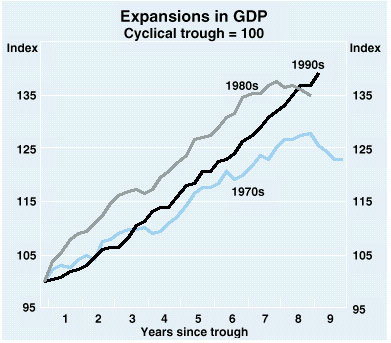
The Reserve Bank, commonly referred as the RBA, has the role of maintaining the inflation rate at around 3 % over a trade cycle, while maintaining sound monetary conditions. To achieve this objective, the RBA compares the current inflation predicts with a specified inflation rate. Since 1993, the RBA has adopted an explicit inflation targeting approach (Organization for Economic Co-operation and Development, 2010, 49).
Fiscal policy in Australia is aimed at balancing the budgetary deficits over a trade cycle. Fiscal policy thus, provides the investors and consumers with a high degree of confidence in spite of the recent economic crisis. In Australia, the fiscal policy helped to balance the budgetary deficit in 1997-1998. Between 198-1999, the fiscal policy moved the Australian finance into surplus. The fiscal policy is currently aimed at further improving the government’s finances (International Monetary Fund, 2006, 9-14).
Other than using the monetary and fiscal policies in enhancing its economic growth, the Australian government has also set up regulatory reforms aimed at improving and promoting its governance. The government has advocated for credible and transparent macroeconomic frameworks.
The structural reforms have resulted to greater flexibility in exchange rates and a better anchoring of the monetary policy. Structural reforms have also provided the central bank with greater credibility in maintaining low rates of inflation (Organization for Economic Co-operation and Development Australia, 2010, 99-100).
The appreciation of the Australian dollar over the last decade has also enhanced the country’s economic growth. Stiff competition among the various financial intermediaries has led to a continued reduction of interest rate margins. The economic growth in Australia is aimed at reducing the unemployment rates in the future (Sloman, Norris, & Garratt, 2010, 287-345).
A graph illustrating Australia’s GDP growth
Obtained from: bilbo.economicoutlook.net
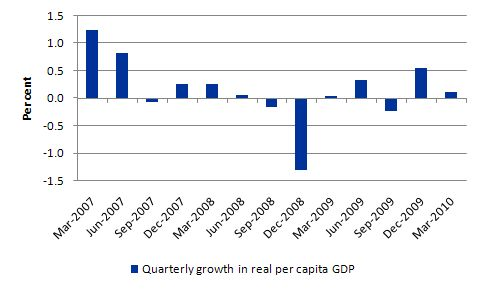
Unemployment polices currently being applied in Australia
The recent global economic crisis has stretched well beyond Australia. It has seen millions of workers across the globe being laid off. Globally, unemployment crisis has become a vast human tragedy (Bell, 2000, 1). The Australian government has laid sound policies that are aimed at attaining full employment. The Australian government has been forced to revise its past unemployment policies, with a view of achieving full employment.
With this regards, the Skills for the Future Inquiry and the Review of South Australian Employment Programs have been set in order to tackle the unemployment crisis. Other policies and strategies that have been undertaken by the Australian government in tackling the unemployment challenges include: the South Australian Strategic Plan, Prosperity through people, Better Skills, Better Work, Better State Strategy and Skills Strategy for South Australia’s Future among others.
These strategies have played an important role in creating a high-skill economy, enhancing access to quality employment and superior workforce planning. According to the Organization for Economic Co-operation Development (2010), Australia has gone further in addressing the unemployment crisis than any other country in Asia-Pacific region.
However, the country faces a major challenge with regards to an ageing population. It is estimated that the Australia’s working-age population grows by approximately 200,000 annually. The ageing population can slow the economic growth as only a small percentage of population in work is forced to support those too old to work. In combating the negative effects of population ageing, the country has set up such measures as enhancing productivity e.t.c. (Emerson, C.2006, 35).
A graph of Australia’s inflation and unemployment from 1995 to date
Obtained from: aussiestockforums.com
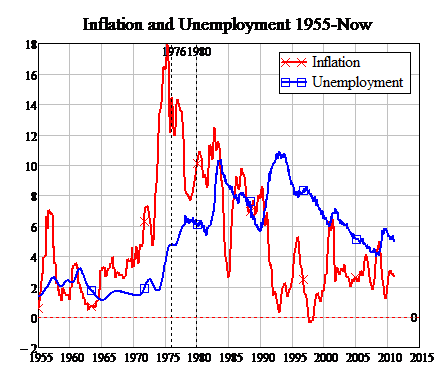
Trade policies currently being applied in Australia
Trade and investment have been major driving forces behind Australia’s economic prosperity and growth. More than 2 million jobs in the country are directly or indirectly connected to imports and exports. Currently, mining is the main economic activity in Australia. The country usually gets bigger and faster gains by allowing regional free trade between its neighbors.
A chart illustrating Australia’s export
Obtained from: dfat.gov.au
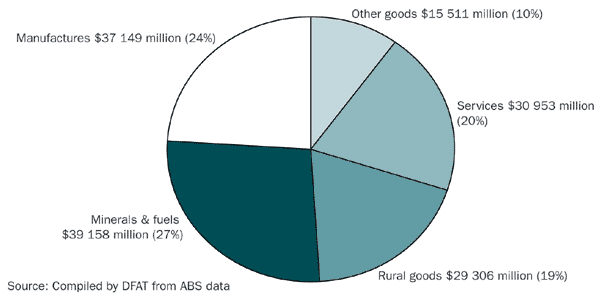
The country’s trade policy is aimed at dismantling the trade barriers with a view of generating immediate gains. This move has enhanced people’s initiative and exchange. Australia strongly supports the World Trade Organization as the main medium for international trade liberalization. In 2001, the Australian government launched the multilateral trade objective during the Doha round of trade negotiations.
The round is aimed at reducing trade barriers and also to Promote Australian goods and services internationally. Australian government has thus encouraged the World Trade Organization to fully participate in the round of trade negotiations. In addressing fluctuations of prices of agricultural products in international market, Australian government joined other nations in forming the Cairns Group.
This group focuses on achieving positive outcomes on agricultural products. Some of the progress that has been achieved so far includes elimination of trade barriers for agricultural products and creation of export subsidies, among others (Gangopadhyay & Chatterji, 2005, 13).
Australia is also a strong supporter of the Asia-Pacific Economic Cooperation (APEC), group which is aimed at enhancing cooperation, economic growth and prosperity in the region. The group ensures that there is free trade and open trade in the wider Asia-Pacific region.
In meeting its objectives, the group leaders have acted to improve security in the region. Economic prosperity cannot be attained without adequate security and thus, the group leaders during a meeting that was held in 2003, proposed the need of enhancing the regional security. With this regards, the APEC group leaders are vested with the responsibility of countering terrorism and securing trade (Yamazawa, 2000, 1).
In an effort to promote its goods and services internationally, Australia negotiates Free Trade Agreements (FTAs), with its key trading partners. FTAs play an important role of opening up all trade in goods, providing an environment that is conducive for trade and investment and negotiating trade deals for member countries.
Australia alliance relationship with New Zealand is important as far as trade and investment are concerned. The Australia New Zealand economic relations began in the early 1980s. Both countries signed the Australia New Zealand Closer Economic Relations (CER) agreement, which supports all the trans-Tasman trade and investments of both countries. Australia has also formed Free Trade Agreements with other countries across the globe such as the United States, Singapore and Thailand (Australian Bureau of Statistics, 2005, 77).
Australia’s Balance of Payment
Obtained from: agsm.edu.au
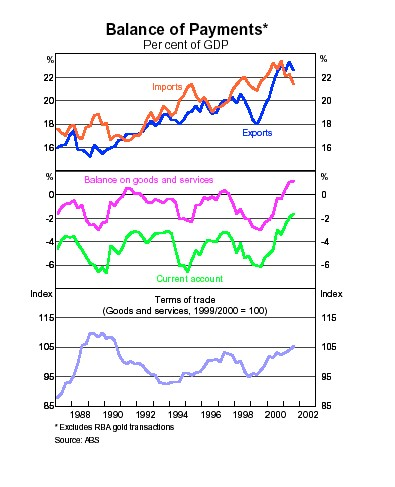
Conclusions and Recommendations
The current macroeconomic performances have proved to be impressive. The country has succeeded in achieving economic growth and prosperity in the face of the global recession. Macroeconomic performances have also resulted to a fall in the unemployment rate to around 6 %. Also, the rate of inflation has remained relatively low making Australia to be one of the few OECD countries with improved standards of living.
However, the country faces a short term challenge of managing the adverse effects of rise of prices of goods and services in the past few years. The increase in commodities price has in turn increased the terms of trade. The government also faces long term challenge of labor supply following the population ageing.
In addressing these challenges, the government should consider enhancing efficiency of its services by clarifying responsibilities and improving cooperation in key sectors of the economy such as agriculture and mining. Similarly, the government can enhance productivity by up-skilling the workforce, improving infrastructural facilities such as road networks among others.
To address the effects of ageing population on labor supply, the government should promote labor force participation to notable groups such as women, disabled, single parents and the old. Also, monetary and fiscal expansion should be carefully kept in check.
Reference List
Australian Bureau of Statistics., 2005. Year book, Australia, Issue 87. Canberra: Aust. Bureau of Statistics.
Bell, S., 2000. The unemployment crisis in Australia: which way out? Cambridge: Cambridge University Press.
Emerson, C., 2006. Vital signs, vibrant society: securing Australia’s economic and social wellbeing. New South Wales: UNSW Press.
Gangopadhyay, P & Chatterji, M., 2005. Economic globalization in Asia. Farnham: Ashgate Publishing Ltd.
International Monetary Fund., 2006. Australia: selected issues. Washington: International Monetary Fund.
Organization for Economic Co-operation and Development., 2010. Australia: towards a seamless national economy. Paris: OECD Publishing.
Organization for Economic Co-operation and Development Australia., 2010. Towards a seamless national economy. Paris: OECD Publishing.
Sloman, J., Norris, K. & Garratt, D., 2010. Principles of Economics: Edition3. New Jersey: Pearson Education Australia.
United Nations, Economic and Social Council, United Nations, Office for ECOSOC Support and Coordination., 2004. Supporting Africa’s efforts to achieve sustainable development: dialogues at the Economic and Social Council. New York: United Nations Publications.
Yamazawa, I., 2000. Asia Pacific Economic Cooperation (APEC): challenges and tasks for the twenty-first century. London: Routledge.